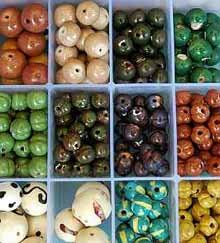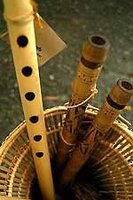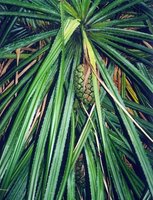So you forked out RM9.50 for a rattan bangle. Big deal, you say. But consider this: the jong betek nahat (arm ornament in the Penan language) was handmade by Stanley Jalong, a 30-something Penan who gathered the rattan from the jungle. The bangle was then transported from Ulu Baram in the deep interior of Sarawak by boat, van and airplane to Kuala Lumpur where you bought it.
( Bujam are small pouches crafted by the Mah Meri ladies which were traditionally used to store tobacco and sweets)
Bujam are small pouches crafted by the Mah Meri ladies which were traditionally used to store tobacco and sweets)
Now, we’re talking about the real value of this piece of
handicraft.
That’s what makes Gerai O. A. (
Orang Asli/Asal) unique. Most crafts sold at Gerai come with individual tags naming the artisans, where he hails from and what the craft was traditionally used for. From
Semelai weaved mats, Temiar
blowpipes to Lun Bawang hand-painted clay beads and Rungus necklaces, Gerai’s products are a showcase of crafts from about 17 indigenous groups in Malaysia.
Run by a bunch of dedicated volunteers, this non-profit mobile stall shows up monthly at the Laman Seni Kuala Lumpur (an arts and crafts bazaar at the National Art Gallery) or a handicraft event in the city.
There’s no rent or utility bills to pay. Volunteers chip in to transport the crafts around, and Gerai’s coordinator Reita Faida Rahim’s apartment doubles as a storeroom. All of the proceeds from the sale of
crafts go back to the artisans.
“Gerai was never planned, it just happened,” says one of its founders, craft researcher Reita, 33. With her graphic design background, Reita used to teach design theory and has researched traditional crafts. Two years ago, she was approached by a group of villagers from an indigenous community.
“They wanted help to sell their
crafts as they were being exploited by middlemen,” says Reita who did her (diploma) dissertation on batik and later shifted her interest to textile, basketry and beads.
Together with a friend, Raman Bah Tuin, a bamboo flute artisan from the Semai community in Cameron Highlands, they set up an impromptu stall at a college event in Oct 2004.
“The Gerai just evolved from there. We started getting phone calls from buyers or people who wanted us to sell their crafts,” says Reita, whose volunteers include students, activists, craftspeople and even journalists.
(Han dpainted beads made by the Lun Bawang ladies of Long Tuma, Lawas, Sarawak).
dpainted beads made by the Lun Bawang ladies of Long Tuma, Lawas, Sarawak).
“We focus on the minority groups, the Orang Asli communities, because they have fewer avenues for help,” adds Reita.
“It’s not realistic for the villagers themselves to come out and trade all the time. We are just giving them an alternative place to market their crafts.”
Middleman syndrome
For most
indigenous craftspeople living in the remote interiors, they count on the middleman to sell their wares.
“But each time a middleman monopolises the market in one village, it creates an avenue for exploitation,” explains Reita.
Some middlemen buy the wares for a fraction of the price and sell them for a huge profit in the cities.
“There were also cases where they took the
crafts without paying, then told the villagers they had lost the things and couldn’t pay.”
Reita hands out name cards of the craftsmen to interested buyers.
“You can contact these craftsmen directly, and bypass the middleperson,” says the genial lady. “Hopefully, it’s the first step to empowerment.”
Gerai doesn’t just sell crafts and help create awareness of our indigenous
cultures, but it also provides technical help to the artisans. Last month, Reita travelled to Long Tuma, near Lawas, Sarawak to buy some clay beads from the Lun Bawang women.
“We advise them on what designs are saleable in the market,” says Reita. “I taught the (Long Tuma) women how to do earrings, necklaces and beaded bracelets that are cost-effective.’’
(A f lute made by the Dusun indigenous group. - Pictures by TAN LEE KUEN & APOI NGIMAT)
lute made by the Dusun indigenous group. - Pictures by TAN LEE KUEN & APOI NGIMAT)
Chronicling tradition
In 2003, with the help of the Centre of Orang Asli Concerns (COAC), 13 Mah Meri weavers formed the Tompoq Topoh – Mah Meri Women’s “First Weave” Project. In Mah Meri language, tompoq means the “first weave”, or it can be interpreted as the start of a new beginning.
Grouped under the Senoi sub-ethnic group, the Mah Meri are coastal dwellers living on Carey Island and in Tanjung Sepat, Selangor. Traditionally, fishermen and padi farmers the Mah Meri today mainly work in the oil palm plantation or tap rubber.
In the past, Mah Meri crafts were mostly utilitarian like tikar (mats) for the floor or sentung (basket) to keep rice. Today, Mah Meri craftsmen are renowned for their high-quality woodcarvings while the women fashion pouches, mats and baskets out of pandanus plants.
“The Tompoq project is about weaving, documenting their heritage and earning extra income,” explains Reita. Gerai sells most of the craft made by the Tompoq group.
“Projek ini bagus. Dulu lepak saja, tak buat apa-apa, cuma borak kosong (This is a good project. Before, we did nothing and just chatted when we were free),” says Maznah Anak Unyan, 38, the project leader.
When we dropped in on the ladies on a Saturday morning, they looked exhausted after staying up till 1am the night before to rush off an order of 150 pieces of sungu duri (weaved basket). The ladies get RM10 per basket and can weave up to three baskets a day.
“Most of the kampung women have only primary school education thus the job choices aren’t that great,” Maznah adds in Malay.
“Now, at least we earn an average of RM75 to RM200 a month, depending on the demand.”
Occasionally, the women also perform traditional dances in cultural shows and get about RM50-RM70 per person per show.
Other than Gerai, the ladies sell their crafts directly to visitors on the island or when they go to town.
The concept of Gerai
“Gerai is unique because it is run by dedicated people. And you cut out the middlemen,’’ says COAC coordinator Dr Colin Nicholas. There’s potential for it to be a commercially viable business.”
“And it certainly puts to shame all those people getting profit from the craftsmen,” adds Nicholas.
COAC also provides support for Orang Asli self-development.
“It would be good if Reita takes Gerai online and sets up a handicraft portal. It’s not just for people to buy but to create more awareness,” said Nicholas.
Source: The Star







